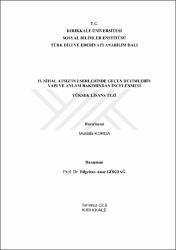| dc.contributor.advisor | Gökdağ, Bilgehan Atsız | |
| dc.contributor.author | Korga, Mustafa | |
| dc.date.accessioned | 2021-01-16T18:55:20Z | |
| dc.date.available | 2021-01-16T18:55:20Z | |
| dc.date.issued | 2018 | |
| dc.identifier.uri | | |
| dc.identifier.uri | https://hdl.handle.net/20.500.12587/14563 | |
| dc.description | YÖK Tez ID: 532076 | en_US |
| dc.description.abstract | Deyimlik yapılar bir milletin tarih içerisinde geçirmiş olduğu yolculuktan izler taşıyan, geçmiş ve gelecek arasındaki kültürel bağın canlı tanığıdır. Milletlerin dünya görüşlerini, gelenek ve göreneklerini deyimlik yapılarda bulmak mümkündür. Bu öbekler, yapılan çalışmalarda daha çok yapısal özellikleri bakımından incelenmiştir. Çalışmada Türk edebiyatının önde gelen yazar ve şairlerinden H. Nihal Atsız'ın Dalkavuklar Gecesi, Bozkurtların Ölümü, Bozkurtlar Diriliyor, Deli Kurt, Z Vitamini, Ruh Adam ve Yolların Sonu isimli eserlerindeki deyimlik yapılar tespit edilmiş; bu öbekler yapıları bakımından iki ana başlık altında incelenmiştir. Tespit edilen deyimlik yapılar anlamsal olarak deyimleşme süreci sonunda ortaya çıkan bütünün anlamsal kapalılığına göre derecelendirilmiştir. Anlamsal kapalılığa sahip ve bileşenlerinin anlamlarından bütünün anlamı tahmin edilemeyen öbekler deyim, anlam aktarımına girmekle birlikte bileşenlerinin anlamlarından az çok tahmin edilebilen öbekler ise deyimce kelimesiyle terimleştirilmiştir. Anahtar Kelimeler: H. Nihal Atsız, Kalıp Sözler, Deyim, Deyimlerin Yapısı | en_US |
| dc.description.abstract | Idiomatic structures are the living witness of the cultural bond between the past and the future, bearing traces of the journey that a nation took in history. It is possible to find the world views, traditions and customs of the nations in idiomatic structures. These phrases have been investigated in terms of their structural characteristics in the studies carried out. In the study, idiomatic structures were identified in the works named "Dalkavuklar Gecesi, Bozkurtların Ölümü, Bozkurtlar Diriliyor, Deli Kurt, Z Vitamini, Ruh Adam ve Yolların Sonu" by H. Nihal Atsız, one of the leading writers and poets of Turkish literature,; these phrases have been examined under three main headings. The identified idiomatic structures were graded according to the semantic closure of the whole that emerges semantically at the end of the idiomatic process. Phrases with semantic closure and whose meanings can not be estimated from the meanings of their components are termed by idiom, while phrases, including semantic change, that can be guessed more or less from the meanings of their components are termed by "deyimce". Key Words: H. Nihal Atsız, Formulaic Expressions, Idiom, Structure of Idioms | en_US |
| dc.language.iso | tur | en_US |
| dc.publisher | Kırıkkale Üniversitesi | en_US |
| dc.rights | info:eu-repo/semantics/openAccess | en_US |
| dc.subject | Türk Dili ve Edebiyatı | en_US |
| dc.subject | Turkish Language and Literature | en_US |
| dc.subject | | en_US |
| dc.subject | | en_US |
| dc.subject | | en_US |
| dc.subject | | en_US |
| dc.subject | | en_US |
| dc.subject | | en_US |
| dc.title | H. Nihal Atsız'ın eserlerinde geçen deyimlerin yapı ve anlam bakımından incelenmesi | en_US |
| dc.title.alternative | The examination of idioms which are in H. Nihal Atsız's works in point of structure and meaning | en_US |
| dc.type | masterThesis | en_US |
| dc.contributor.department | KKÜ, Sosyal Bilimler Enstitüsü, Türk Dili ve Edebiyatı Anabilim Dalı | en_US |
| dc.identifier.startpage | 1 | en_US |
| dc.identifier.endpage | 260 | en_US |
| dc.relation.publicationcategory | Tez | en_US |
















